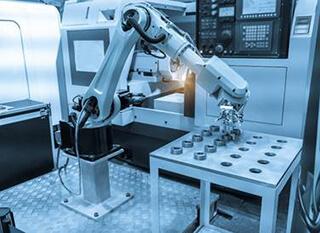We’re on the brink of a revolution – a new industrial revolution.
Across the world, businesses are digitally transforming the way they operate, and the backbone of this transformation is the Industrial Internet of Things (IIoT). IIoT comprises internet-connected, software-managed machinery and devices and the advanced analytics platforms that process the data they produce, all of which combine to create operational efficiencies. An IIoT-enabled business has access to an array of benefits driven by connected technologies, including:
- Improved decision making
- Reduced overhead costs
- Real-time marketing
- Reduced human intervention
- Higher-quality data
- Better customer experiences
- Process improvement
- Optimized asset utilization
- Self-monitoring and predictive maintenance
- Reduced downtime and greater efficiency
- Supply chain optimization
- Improved building/facility security
While the word industrial may invoke visions of warehouses, ports and factory floors, IIoT technologies hold a lot of promise for a diverse range of industries, including power/energy, agriculture, aerospace, healthcare, financial services, retail and advertising. Yet there are still IIoT challenges that must be solved.
The Challenges of IIoT
One of the biggest challenges about IIoT systems is that they generate and must collect massive amounts of data – but IIoT applications that generate hundreds of terabytes and petabytes of data by the hour may be unable to transmit such huge amounts of data over the Internet fast enough to enable real-time decision making. It is not only costly, but could cause network congestion and slow the connection due to bandwidth concerns – not to mention, all the data in the world is no good if it’s not coming in real time.

Additionally, all IIoT applications require a stable and versatile storage environment that can withstand extreme conditions and long life cycles. Various usage cases spanning diverse workload scenarios mean that IIoT solutions have to be suited to specific applications, as one size does not fit all, and faster or bigger is not always better. That means the solution may come in a small form factor: the SD memory card, supported by the SD Association’s latest standard, SD Express.
SD Express: Solving IIoT Challenges
The SD Express PCI Express (PCIe®) interface, compliant with the NVM Express® (NVMe™) protocol, now is integrated into SD memory cards alongside legacy SD interface. In anticipation of the next generation of high-performance mobile computing requirements, adding PCIe technology and the advanced NVMe protocol delivers faster access to data files than today’s SD platform, achieving speeds of up to 985 MB/s. An upper-layer protocol allows advanced memory access mechanism, enabling a new world of opportunities for the popular SD memory card. This new protocol allows SD Express memory cards to serve as removable solid state drives (SSD).
Additionally, SD Express memory cards aid in edge storage, which is necessary when the scale of the system consists of too many devices or too many different types of applications. Edge storage provides faster data storage time, at-source monitoring, and caching and filtering data that is not useful for long term storage, as well as adds another layer of security to back up cloud storage.
Edge storage – inevitable in the IIoT transformation – can be supported by SD memory cards. SD Express memory cards with PCIe/NVMe interfaces stretch the capabilities of IIoT edge ecosystems by delivering portability, scalability and ultra-low latency for reliable data storage and redundancy; future-proof infrastructure investment; agile analytics; and overall greater productivity. Additionally, SD Express memory cards will extend the storage and performance capabilities of IIoT edge gateways.
Gateways on the IIoT Edge
Gateways serve as a bridge between the network of devices/machines and the cloud. Gateways are placed on the edge of the network for two main reasons: aggregation of the devices or subsystems, and supporting edge storage/computing.

We are currently at the stage of transformation that aggregates different platforms of applications and an increases the amount of machines in the system. The next stage will integrate numerous devices and subsystems with varied data types. Pure cloud storage and computing is impractical and may not be able to catch up with the pace of, for example, an automated factory with thousands of machines communicating and collaborating at full speed, due to constrained bandwidth. In addition, the factory may be located in a remote area where internet access is limited; where environmental factors inhibit Wi-Fi signals; or where it would be too costly to install a signal tower.
For these reasons, gateways that can filter, integrate and process large amounts of data at the edge of the system are essential to avoid a high-latency situation – for example, in a factory in which hundreds of machines are running and one machine is overheating. The sensor in that machine will continuously send the temperature data to the gateway, and the on-site manager can react quickly – or the gateway will have some edge computing capability to automatically shut down the machine to prevent misprocess or machine damage.
With the enhanced performance and speed of NVMe/PCIe, which effectively transforms the card into a removable SSD, SD Express memory cards will boost the storage and performance capabilities of IIoT edge gateways. SD Express delivers the sequential and random performance for next-generation applications, making it suitable for multi-channel edge computing, including data acquisition from all of the connected machines and devices in an IIoT environment.
A Data Explosion
The amount of data being generated every day is staggering, and growing each year. By 2020, it’s estimated that for every single person on earth, 1.7 MB of data will be created every second. It’s a number so large that it’s incomprehensible – and this explosion of data is both a challenge and an opportunity for businesses looking to revolutionize their processes and operations through the implementation of IIoT.
With superior speed and performance, SD Express can handle the massive amounts of data generated by the IoT/IIoT, such as those from extensive sensor networks, as well as high-resolution, content-rich and speed-hungry applications – making SD memory cards key to the IIoT revolution.
Alice Chou is Senior Product Manager for Phison. Chou can be reached at alice_chou@phison.com.
PCI Express® is a registered trademark of PCI-SIG®.
NVM Express™ and NVMe™ are trademarks of NVM Express, Inc.
© SD Association. All rights reserved. SD, microSD, SDHC, microSDHC, SDXC, microSDXC, SDUC, microSDUC Logos are trademarks licensed by SD-3C LLC.



